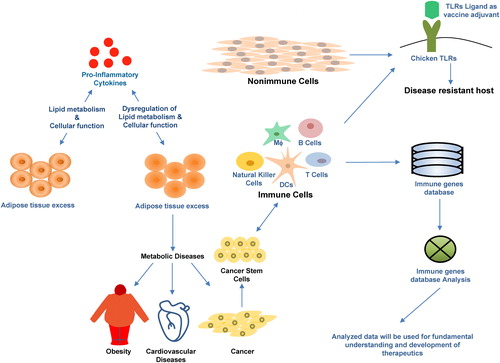A multidisciplinary approach among various disciplines of sciences is essential for gaining a deeper insight of host immunity. This approach also provides an opportunity to manipulate the defense system at a cellular and molecular level. Technological advancements further enhance the precision of maneuvering pathogenic molecules, derived either from host or pathogen, involved in pathogenesis to overcome diseases. This issue of International Reviews of Immunology highlights the impact of metabolic pathways, dedifferentiation of normal cells to cancerous stem cells and their interaction with immunity, and the use of immune genes in chickens for producing disease-resistant poultry breeds. The issue also discusses how computational tools help us to better understand diseases and develop effective vaccines ().
Figure 1. Integration of various disciplines of science for the better understanding of host immunity.

Inflammation is an initial alert response to infection, injuries, and endogenous changes in cellular and molecular homeostasis. A moderate level of inflammation is essential for the clearance of microbial infection, wound healing, and/or tissue repair. In contrast, chronic or heightened inflammation leads to a wide range of immunopathology, such as pain and fever, or even metabolic, autoimmune diseases, or cancer. The first review article of this issue by Chen et al. discusses the links among adipose cells, lipid metabolism, proinflammatory cytokines, and metabolic diseases, including cancer, and how lipid metabolism induces oncogenesis through the production of inflammatory cytokines [Citation1]. This article is useful to researchers and clinicians investigating the boundaries of metabolism and development of multifactorial metabolic diseases and looking for sustainable novel therapeutic targets ().
The interaction between cancer and immune cells in a cancer microenvironment skew the immune cells’ function in such a way that immune cells are ineffective or inefficient in eliminating cancerous cells. Furthermore, the cancer microenvironment rewires the signaling pathways in cancer cells so that cancer cells acquire pluripotency and dedifferentiate to cancer stem cells. The second review of this issue by Rajayia et al. focuses on the interaction of cancer stem cells with immune cells and discusses strategies for eliminating cancer stem cells by eliciting immune functions of immune cells using different strategies of immunotherapy [Citation2]. The article will be useful to broad readers of oncology and onco-immunology and to clinical oncologists ().
Enhancing production of animal food is key for worldwide food security. However, generating disease resistant animals is a big challenge. The Toll-like receptors (TLR) are sentinel to the host against an array of microbial infections in humans, mice, and different animals including chicken. The third article of this issue by Nawaba et al describes the potential of TLR ligand as a vaccine adjuvant and its wide application against different bacterial, viral, and parasitic poultry diseases [Citation3]. The article particularly focuses on chicken TLR4 and explores the possibilities for generating disease-resistant breeds, which will be a step towards food security ().
For better understanding of biological processes, advanced technologies have been implemented which generate tremendous data. To understand complex data sets and draw meaningful conclusions, high computational strength is required, which results in the birth of new disciplines like bioinformatics or immuno-informatics. These fields provide unbiased, novel information or possibilities, which can be explored by biologists or immunologists for combatting all kinds of diseases. The last article of this issue by Bahramia et al discusses the strength of computational analysis in developing effective vaccines for various diseases. The article provides an overview of computational tools used in vaccine development [Citation4]. This article will be useful to broad readers of immunology, immunoinformaticians, computer scientists, and industries involve in vaccine development ().
References
- The role of pro-inflammatory cytokines in lipid metabolismof metabolic diseases. Int Rev Immunol 2019;38(6):249–266. doi:10.1080/08830185.2019.1645138.
- Cancer stem cells targeting; the lessons from the interactionof the immune system, the cancer stem cells and the tumor niche. Int Rev Immunol 2019;38(6):267–283. doi:10.1080/08830185.2019.1669593.
- Chicken toll-like receptors and their significance in immune response and disease resistance. Int Rev Immunol 2019;38(6):284–306. doi:10.1080/08830185.2019.1659258.
- Immunoinformatics: in silico approaches and computational design of a multi-epitope, immunogenic protein. Int Rev Immunol 2019;38(6):307–322. doi:10.1080/08830185.2019.1657426.
